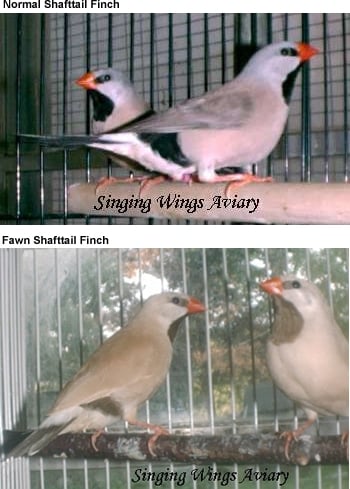Shaft-tail Finch, Heck’s Shaftail, Long Tailed Grassfinch
The Shaft-tail Finch has a silver-gray head with a rosey-brown body. A black eye mask extends from the beak to the eye and a unique black bib can be seen under the lower beak reaching the upper breast.
The photos and below information are courtesy of Mandy and Paul – Breeder of Canaries and Other Exotic Birds – Singing Wings Aviary – www.singing-wings-aviary.com (A great source for these beautiful little finches.
Description:
In its normal form, the Shaft-tail Finch has a silver-gray head with a rosey-brown body. A black eye mask extends from the beak to the eye and a unique black bib can be seen under the lower beak reaching the upper breast.
The rump is white with a black band above it. Central tail feathers are black while the beak is red. They have flesh-red colored legs.
Both sexes look identical with only slight differences in body size, beak color, and bib size.
Males are typically bigger and have a wider bib and brighter beaks. Head bobbing is seen in both sexes but is more often performed by the males.
Size:
These birds average 5-6 inches (13-15cm) and are hardy birds.
Origin:
The Shaft-tail orginates from Australia and is still very numerous second only to the Zebra Finch. A red-billed sub-species (Phophila acuticauda hecki) from the western region is now more common in US aviculture than the original yellow-billed species (Phoephila acuticauda) from the eastern region.
Diet:
A good Shaft-tail Finch diet is a mixture of mixed millets available in a good finch mix. Fresh water, cuttlebone, and grit should also be supplied at all times. Lettuce, Spinach, Chickweed, spray millet, Eggfood, Brocolli tops, and Carrot tops can also be offered regularly. These guys love the food and sprouted seeds.
Sprouted or germinated seeds are usually more easily accepted by “seed addicts” than fresh fruits and vegetables.
- Sprouted seeds are healthier as the sprouting changes and enhances the nutritional quality and value of seeds and grains. Sprouted seeds are lower in fat, as the process of sprouting utilizes the fat in the seed to start the growing process – thus reducing the fat stored in the seeds.
- Sprouted seeds will help balance your bird’s diet by adding a nutritious supply of high-in vegetable proteins, vitamins, minerals, enzymes, and chlorophyll.
- Soaked and germinated “oil” seeds, like niger and rape seeds, are rich in protein and carbohydrates; while “starch” seeds, such as canary and millets, are rich in carbohydrates, but lower in protein.
- It is an invaluable food at all times; however, it is especially important for breeding or molting birds. Sprouted seeds also serve as a great rearing and weaning food as the softened shell is easier to break by chicks and gets them used to the texture of seeds.
General Care:
Do not forget to trim your Shafttail Finch’s nails on occasion and provide bath water daily!
Compatibility:
This species is normally a good prospect for a mixed aviary. They get along well with each other and other finches although they may bicker on occasion with smaller waxbills during the breeding season.
Housing:
These birds do best in a large planted aviary. If you are wanting them to breed you can separate them by pairs into large flights or breeding cages.
We prefer to house them in single-pair planted flight cages. Some heat will be required during winter months so these birds are best suited for large indoor aviaries during winter.
In the summertime, they will thrive and come into the best condition in outdoor aviaries provided you provide shelter to keep them from damp conditions.
Song:
This species of bird is very comical to watch when singing. They take turns bobbing their head while the male sings his series of call songs. The female will call but she will not sing the full song like the male.
Breeding:
Shaft-tails can be cage or aviary bred. Better breeding results seem to come when pairs are housed separately. We house each pair in a 36 x 20 x 20 flight with bamboo coverage for privacy.
Birdhouse gourds and finch nest boxes are offered for the nest. They seem to prefer the nest boxes in which they can lay deep in and hide.
Shaft-tails will use a variety of nesting materials such as coco fiber, shredded paper, dried grasses, and feathers.
They must build the nest themselves and will not tolerate you building it for them.
I have shaped the nest for them in the past only to have them tear it out and start over.
After breeding takes place the hen typically lays 4-7 eggs which both parents take turns incubating for 14 days.
After hatching it will be about 21 days before the young leave the nest. At about 42 days old the young Shafttails are weaned and independent.
Further Finch Reading
- Finch Information
- Index of Finch Species
- Photos of the Different Finch Species for Identification
- Common Health Problems of Finches
- Finch / Canary Diet / Nutrition





